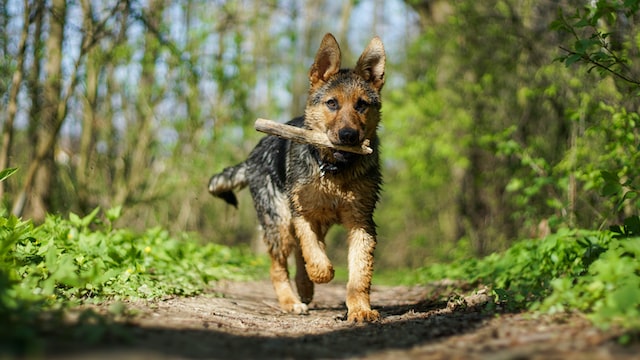Cancer in dogs, much like in humans, is caused by uncontrolled cell growth. Various factors can contribute to its development and it’s often a combination rather than a singular trigger. Here are some key factors:
- Genetics: Some dog breeds are more genetically predisposed to certain kinds of cancer. For example, Golden Retrievers have a higher likelihood of developing lymphoma and hemangiosarcoma.
- Age: Older dogs are more prone to cancer. Statistics suggest that one in four dogs will develop cancer at some point, with half of all dogs over the age of 10 developing the disease.
- Environment: Exposure to harmful environmental factors such as certain pesticides, tobacco smoke, and radiation can increase the risk of cancer.
- Viruses: Certain types of viruses have been linked to cancer, including the canine papilloma virus.
- Hormones: Studies have shown that dogs that aren’t spayed or neutered have a higher risk of developing certain types of cancer, specifically mammary and testicular cancer.
- Diet and Exercise: Obesity and lack of exercise can increase a dog’s risk of developing certain types of cancer. A healthy, balanced diet and regular exercise can help to mitigate this risk.

Body areas prone to cancer
Cancer can form in virtually any part of a dog’s body, again, much like in humans. Some of the most common types of cancer in dogs occur in the following regions:
- Skin: Skin cancer is very common in dogs and manifests as abnormal growths or sores that don’t heal.
- Mammary Glands: Mammary gland tumours are the most common in unspayed female dogs.
- Head and Neck: Oral cancer is quite common in dogs. They can also get cancer in the nasal cavity.
- Lymph Nodes: Lymphoma is a cancer of the lymph nodes and is common in certain breeds.
- Testicles: Testicular cancer is common in dogs, particularly those who haven’t been neutered.
- Bones: Osteosarcoma, or bone cancer, often affects the larger breeds of dogs.
- Abdominal Organs: Cancer can occur in the liver, spleen, or gastrointestinal tract. Hemangiosarcoma, a cancer affecting blood vessels, can develop in the spleen or liver and is common in some breeds.
The type, location, and extent of the cancer will determine the treatment protocol and prognosis. Regular vet check-ups are beneficial as early detection can significantly improve treatment outcomes.
Neutering / Spaying effects on cancer
Having your dog neutered or spayed can significantly reduce the likelihood of certain types of cancers. For male dogs, neutering eliminates the risk of testicular cancer, as they are no longer present. Neutering can also reduce the risk of prostate problems, including prostate cancer.
For female dogs, being spayed before her first heat cycle significantly reduces the risk of mammary cancer, which is very common in female dogs. The risk increases with each heat cycle the dog goes through, so early spaying has the most protective effect.
Pedigree dogs and cancer
Pedigree, or purebred, dogs have a higher risk for developing certain types of cancer due to genetic predispositions associated with specific breeds. This is often a result of selective breeding for specific traits, where unfortunately, susceptibility to certain diseases, including cancer, inadvertently becomes concentrated in these breeds. For instance, Golden Retrievers, Boxers, and Rottweilers have a higher genetic predisposition to certain cancers. It has been observed that Golden Retrievers are more prone to lymphoma and hemangiosarcoma, Boxers are susceptible to mast cell tumours, and Bernese Mountain Dogs have a higher risk of histolytic sarcoma. When breeding dogs it is important to take into account past illnesses in dogs in case there are any genetic predispositions to certain diseases.
However, this does not mean every pedigree dog will develop cancer. These are general trends and individual health can vary greatly. Just because a dog is of a certain breed, it does not guarantee illness. Likewise, being a mixed breed dog doesn’t provide a surefire protection against cancer, though genetic diversity in mixed breeds might reduce the risk of certain inherited conditions. Regardless of breed, regular veterinary check-ups, a balanced diet, a healthy weight, and plenty of exercises are all important for reducing the risk of cancer and other diseases in all dogs. It’s always important to be aware of your breed’s specific health risks in order to monitor symptoms and catch any potential issues early.
Signs to keep an eye out for
Cancer symptoms in dogs can vary greatly depending on the type and stage of the disease. However, here are some common signs:
- Abnormal Lumps or Swellings: Any new lump or bump that doesn’t go away or is growing should be checked by a vet. Not all are cancerous, but only a vet can determine this.
- Sores That Don’t Heal: Sores or ulcers that don’t heal can be a sign of skin cancer.
- Weight Loss: Sudden, unexplained weight loss can be a symptom of many illnesses, including cancer.
- Loss of Appetite: Dogs with cancer often lose their appetite. This is generally accompanied with weight loss.
- Difficulty Eating or Swallowing: This could indicate an oral tumour.
- Abnormal Discharges: Nasal discharge, vomiting, diarrhoea, or even blood can be a symptom of certain types of cancers.
- Persistent Cough: Like in humans, a reoccurring cough can signal lung issues, including cancer.
- Difficulty Breathing, Urinating, or Defecating: This could be a sign of tumours in the relative organs.
- Lethargy or Decrease in Stamina: Reduced desire to play or seeming generally listless can be an early signal of cancer.
- Changes in Behaviour: Any unexplained changes in behaviour can be a warning sign. Generally this comes along with some of the other symptoms 1-9.
It’s important to note that these signs can also indicate conditions other than cancer. If your pet displays any of these symptoms, you should consult with your vet for a proper diagnosis as soon as possible. Diagnosis is generally done with a blood test, imaging (CT scan or X-Ray) or via biopsy.
